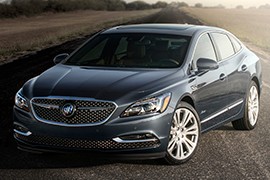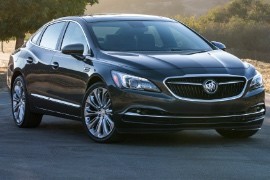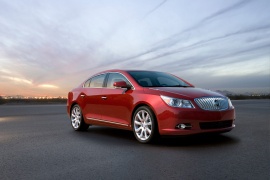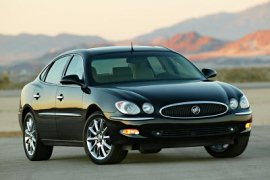BUICK LaCrosse Models/Series Timeline, Specifications & Photos
First production year: 2004
Engines: Gasoline, Hybrid
Buick dared for more and introduced the Avenir as an upscale version for the third generation of the LaCrosse in 2017 for the 2018 model year.
Ever since the introduction of the LaCrosse nameplate in Buick’s inventory in 2004, nine out of ten customers took the top two trim levels of the car, the CXL and the CXS. As a result, GM’s marketing department thought about introducing an even better-equipped version of the car, above what the CXS could provide. The new version of Buick’s mid-size sedan, named Avenir, arrived in 2017 for the 2018 model year. Unfortunately, the car was available just until 2019, when GM decided to pull the plug on the LaCrosse lineup after it decided to restructure its entire organization. The Avenir nameplate wasn’t new. Buick used it previously on the second generation of the Enclave that it launched in January 2017 at the New York International Auto Show.
The difference between the LaCrosse and its more luxurious sibling, Avenir, was striking. Instead of the waterfall grille, the new version featured a 3-D type mesh design that covered the broad upper grille of the car. Buick used the same pattern to adorn the lower side of the bumper and even added two chromed trims that underlined the halogen fog lamps. Surprisingly, the headlights were Xenon, even though the Enclave was available with LED headlamps.
From its profile, the car boasted the Buick-specific three VentiPorts on the front fenders, symbolizing the V6 under the hood. The car’s profile boasted a luxurious appearance thanks to its large 19-inch alloy wheels, with an option for 20-inch ones. Furthermore, the front doors boasted the Avenir badges so customers could brag about their upscale LaCrosse. Since the bodywork was basically the same as the one from its lesser-equipped brother, it shared some other details, such as the enlarged rear quarter panels that looked like shoulders over the rear wheels. Finally, at the back, the L-shaped LED taillights were extended onto the trunk lid.
Inside, the LaCrosse Avenir boasted a leather-wrapped cabin with a Chestnut color theme. Still, the steering wheel was the same as the one from the rest of the LaCrosse range. Fronting the driver was a three-dial instrument cluster with a small TFT display that showed data from the car’s onboard computer. On the center stack, integrated into the dashboard and placed between the center vents, Buick installed the infotainment’s system touchscreen. Customers were spoiled with bolstered front seats separated by the center console that housed the gear selector and a pair of cupholders concealed under a retractable lid. In the back, the bench seat was profiled for two.
Buick offered the Avenir with a 3.6-liter engine paired with a nine-speed automatic transmission. Power went to the front wheels, but a twin-clutch AWD system was also available.
Buick continued its attack on the premium segment with the introduction of the third generation of its mid-size sedan LaCrosse, which it launched in 2016 for the 2017 model year.
GM pushed the skinny pedal harder on its R&D department to launch the third generation of the LaCrosse as soon as possible. As a result, just three years after it unveiled the facelifted version of its predecessor at the 2013 New York Auto Show, it was ready to deliver the new model. Moreover, in the summer of 2016, the car was already in showrooms waiting for its customers. Buick built the car on a new platform named P2XX, which was the long-wheelbase version of the one used by Chevrolet to create the Impala and by Opel/Vauxhall to make the Insignia. Buick was also a very famous brand in China, so GM used it to get a bigger slice of the market. It even created specific versions of the LaCrosse, with designated engines and transmissions according to its customers' needs.
By 2016, the car's front fascia was already recognized by customers thanks to the waterfall grille, with black vertical slats, and adorned by the brand's logo supported by wing-like, almost horizontal chromed slats. Its headlights resembled those from the European Insignia, with upper-outer L-shaped daytime running lights. Lower, on the bumper, the automaker added a horizontal chromed slat that crossed the car from side to side in front of an air intake placed in the apron.
From its profile, the sculptured body panels evoked older Buick models, with wider shoulders at the back over the rear wheels. Like its predecessor, the 2017 LaCrosse featured a low-slung greenhouse with a sloped-down rear window and a short, curved deck. Finally, at the back, the automaker installed L-shaped LED taillights that were extended from the quarter panels onto the trunk lid. Buick made the car for several markets, including the Chinese one, where it enjoyed great success.
Inside, customers found a high-tech ambiance with a modern dashboard that neatly integrated the infotainment's touchscreen between the vents on the upper side of the center stack. In front of the driver, Buick installed a clean-designed instrument panel where the speedometer took center stage. Like in the previous generation of the LaCrosse, it was flanked by the tachometer and the oil temperature dials on the left and by three additional gauges on the right for the fuel level, water temperature, and ammeter. The high-bolstered front seats kept their occupants in place during high-speed cornering, while in the back, the bench profiled for two was comfortable.
Under the hood, GM installed different engines, depending on the country. For U.S. customers, the automaker used a 2.5-liter hybrid drivetrain and a 3.6-liter V6 powerplant, while for the Chinese market, it used inline-three and inline-four engines, with or without an electric motor assistance. Power went to the front or in all corners, depending on the market and engine version.
Buick introduced the second generation of the LaCrosse in 2009 for the 2010 model year, and it was a completely new approach to a market that shrunk under the pressure of the world financial crisis.
GM tried to attract younger customers to the Buick brand, and the LaCrosse was an essential part of its strategy. The vehicle was based on the same platform as the European Opel/Vauxhall Insignia. As a result, besides the front-wheel drive versions, it was also available with an all-wheel drive system, a first for Buick's sedans. Moreover, the car's styling and interior technology package were dedicated to those who used to listen to their music streamed from phones via Bluetooth, not just from an XM Satellite radio.
At the front, the waterfall grille with vertical slats was impressive and lost the oval shape of the previous generation of the LaCrosse. Its chromed finishes made it look upscale, while the new projector beam headlights resembled other premium cars made by Lexus, Infiniti, or Acura. Furthermore, the lower part of the bumper sported a center air intake flanked by a pair of side scoops that housed the fog lamps.
From its profile, the car's ascending belt line and the greenhouse's low-slung look gave the 2010 LaCrosse a sportier appearance. Furthermore, the sculptured door panels resembled the famous Y-Job concept car from the '30s, the Riviera, and the Roadmaster. Depending on the trim level, the large premium sedan sat on standard 17-, 18-, or 19-inch alloy wheels. The back of the car showed wide corner-mounted taillights that cut a big chunk from the trunk's lid, while under the bumper, the vehicle boasted a dual exhaust system. Like its predecessor, the second generation of the LaCrosse came in three grades: CX, CXL, and CXS.
Inside, customers found a luxurious cabin with available velour upholstery or suede. Fronting the driver was a more complex instrument cluster that boasted up to six dials. Besides the classic speedometer, tachometer, fuel level, and coolant temperature, Buick also added gauges for the oil temperature and battery status. In addition, an LCD for the advanced safety systems was in the middle of the speedometer dial. The bolstered front bucket seats provided good side support for high-speed cornering maneuvers, while in the back, the automaker installed a split-folding bench seat for up to three passengers.
Under the hood, the LaCrosse came with a choice of three engines. A 2.4-liter inline-four powered the base version, while two V6 powerplants were also available. All versions were paired with six-speed automatic transmissions with manual override. The all-wheel independent suspension with adaptive dampers was a novelty for the American luxurious sedan, and that ensured its younger customers that the car would do well on a winding road.
Buick introduced the LaCrosse in 2004 as a replacement for the Regal and the Century models in the automaker’s lineup, offering a luxurious-looking vehicle and a smooth ride to its customers.
The premium American luxury brand was already a century old when it introduced the LaCrosse nameplate in its inventory. Buick built it on a heavily revised W-Body platform used by the Pontiac Grand Prix, and it was available exclusively as a four-door sedan. It was reckoned for its smooth ride and comfortable seating. In addition, it was the first car in 2006 to receive the SULEV (Super Ultra Low Emission Vehicle) certificate for California, and that helped the automaker boost its sales.
One of the car’s best assets was its look. With its quad headlights, the front fascia resembled a Jaguar, and the wide oval-shaped grille where the three-shield Buick badge took center stage offered the car a premium look. On the bumper, the automaker added a few chromed trims that complemented the one that surrounded the upper grille. The lower side of the bumper sported an additional air intake and a set of fog lamps that flanked it.
From its profile, the long wheelbase and the fluid lines made the LaCrosse look elegant and ready for trans-continental travels. The body-colored door mirror caps and the chromed door handles emphasized the car’s luxurious appearance. The long greenhouse featured a sloped-down rear window, while behind it was a short trunk lid. Finally, at the back, the corner-mounted taillights looked inspired by European vehicles, mostly from the E-Class from Mercedes-Benz W211. Buick made the vehicle in three trim levels: CX, CXL, and CXS. The first two grades came with 16-inch alloy wheels, while the latter sported 17-inch ones.
Inside, the automaker offered up to six seats, with benches on both rows as an option, while all the grades came fitted as standard with seating for five. Buick installed a classic yet elegant cabin, with wood grains on the dashboard and the door cards complemented by chromed trims. Versions fitted with two bucket seats at the front were separated by a wide center console that housed the gear selector, while the buttons and knobs of the CD stereo and the HVAC system filled the center stack. Fronting the driver was a rounded-shaped instrument cluster where the speedometer took center stage. The tachometer was on its left, while the fuel gauge and the coolant temperature were on the right dial. Despite the long wheelbase of the vehicle, legroom in the back was not impressive, but at least the automaker offered the LaCrosse with either fabric or leather upholstery to make it look luxurious. Last but not least, the 60/40 split-folding rear bench seat was standard.
Under the hood, Buick installed the famous 3.8-liter V6 engine that ran in GM’s family for years. In addition, a punchy 5.4-liter LS4 V8 was on the options list. All versions were paired with a four-speed automatic that sent power to the front wheels.



